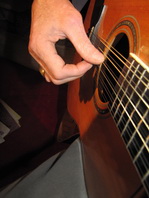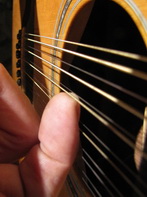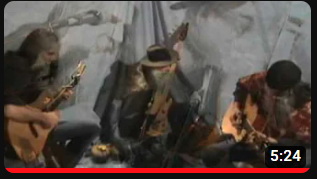I want to talk about right hand finger-picking technique for a minute. I watch a lot of videos online and I see a common problem that is holding a bunch of you back. Please let me fix that with a thing I learned from my early years of Flamenco guitar lessons.
It gets rid of the scratchy sound and makes your fingers work the way your brain does. When that happens, movements happen much more smoothly. If you feel like you are stuck or you are not happy with your finger-picking style, the next few paragraphs can change your life.
Hold up your right hand and make that "come here" motion.
That is how your finger works. It curls in towards your palm.
Turn your hand over and, using the same motion, scratch your knee. Now, scratch your belly button.
See what you did? If you are like most people you turned your hand and instead of curling your finger toward your nose you curl at an angle towards your hip. The higher you scratch the more your hand turns. Scratch your forehead and you are closer to returning to the natural motion of your finger lining up its motion perpendicularly to your body.
When you grab your guitar and start strumming your elbow probably naturaly falls to the crook where you have range of motion. This lets you swing your arm when need be.
When you fingerpick you don't need that. It helps if you reposition your elbow a little.
Now look at how you pluck a string. If you are like most people you are probably turning your hand and scratching across the string toward a spot somewhere between your armpit and the strap-pin. When you are not perpendicular to the string
you actually pull across a couple of the windings and, though it is subtle, there is a scratchy sound... your nail against the windings, click,click,click.
When you turn your hand you move your finger at an angle which presents a wider fingertip to the already limited space between strings. This is particularly important on a 12-string where the space may be significantly smaller.
Your fingertip is 1/4 inch thick nail to pad. When you turn it sideways, it is a 1/2-inch wide scraper.
So let's all stop doing that. Imagine the face of a clock on your guitar. 12 is between your feet and your nose is 6. The direction of travel of your finger is probably hitting somewhere around four o'clock when you turn your hand.
What you want is six o'clock. (The direction of travel of your finger should be from 12 to 6.)
To accomplish this, hold your guitar as you naturally would, sitting or standing. Place your flat right hand over the hole or pickups Now, without moving your arm rotate your hand down so that your fingers are point straight down, perpendicular to the strings.
Stick your thumb out and make a right angle and rest it on the top string. Now move your wrist away from your body, curling your fingertips in toward the strings
Rest your first finger on the third string, your second finger on the second string and your third finger on the first string. Your thumb should still be on the sixth. Notice the inverted "V" between your first finger and your thumb.
Adjust the width of the opening of the V until your thumb and fingers make their natural motion in as perpendicular a path to the string as possible.
TL;DR: That sounds really complicated when you write it all out. Make your finger's natural movement flow in the direction that eliminates the scratchy sound and present your fingertip parallel to the string, stroking straight up toward six o'clock. BAM! Go to work.

Editor's Note:
This is what your fingernail looks like to your strings. So you can see how scratching across them can add noise to your clean fingerpicking. A subtle noise is still noise.
















